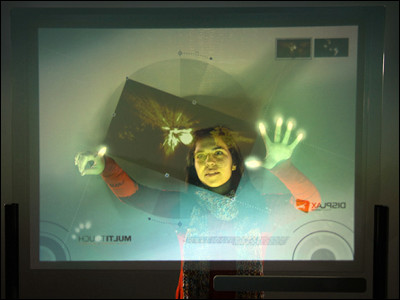A speaker that can be attached to the wall as thin as paper will be developed.

A research team at
An Ultra-Thin Flexible Loudspeaker Based on a Piezoelectric Micro-Dome Array | IEEE Journals & Magazine | IEEE Xplore
https://ieeexplore.ieee.org/document/9714188
Researchers develop a paper-thin loudspeaker
https://techxplore.com/news/2022-04-paper-thin-loudspeaker.html
Speakers commonly used in headphones and audio systems generate a magnetic field by passing a current with a sound signal through a coil, and this magnetic field moves the diaphragm of the speaker, and the vibration is transmitted to the air to reach the sound. It is a mechanism. On the other hand, the type called a thin speaker simplifies this structure by using a piezoelectric element that converts voltage into force and vibrates the air. However, most thin speakers do not produce sound unless the diaphragm can move freely, so they are designed to stand on their own, and if they are attached to a surface such as a wall, they will not produce sound.
Therefore, the research team of Professor Vladimir Bulović, who is the director of MIT.nano, reconsidered the design of the thin speaker and developed a structure that vibrates multiple 'small layered dome of piezoelectric element' instead of vibrating the whole. bottom. The research team first made a small hole in thin polyethylene terephthalate (PET) with a laser, laminated polyvinylidene fluoride (PVDF) , which is a piezoelectric element, on the underside of the PET, covered the laminated sheet with a vacuum, and placed a heat source on the underside. Did. The PVDF layer is so thin that when the current heats the heat source, it expands due to the pressure difference with the vacuum and protrudes from the PET hole as a small thin dome.
The PVDF dome is only about 15 microns (0.015 millimeters) high and vibrates up and down with a width of about 0.5 microns (0.0005 millimeters) in response to electrical signals. Although the sound transmitted by one dome is very quiet, arranging thousands of domes can produce a sound that is audible to the human ear. In addition, the dome is protected by a spacer layer that secures space, and it can vibrate freely regardless of the mounting surface, so it is possible to make a sound even when it is stuck to the wall.
You can see what the thin speaker developed by the research team looks like by watching the following movie.
A paper-thin loudspeaker plays 'We Are the Champions' by Queen --YouTube
What a man has in his hand is a thin sheet with two electrodes connected.

When you wave your hand, it flutters like paper.

It doesn't look like a speaker, but when I turned the seat side toward the screen, I started to hear QUEEN's '

If you remove the electrodes, you will not hear any sound.

When I attached the electrodes, I could hear the sound again.

Only 100 milliwatts of power is required for this speaker to produce sound in a 1 square meter space. The power required for the average home speaker to produce the same sound is 1 watt or more, which shows that it is very energy efficient.

Even if you bend it tightly, the sound will not disappear. With this characteristic, it can be attached to the wall of a room or car to make a sound, or it can realize stereophonic sound in theaters and theme parks, and it is also ideal for smart devices with limited battery life.

Jinchi Han, a postdoctoral fellow who is the lead author of the paper, said that manufacturing thin speakers is 'a very simple and easy process' and that mass production is possible in the future. .. In addition, by applying the mechanism that generates vibration, it can be diverted to human position detection technology using ultrasonic waves, chemical processing technology that stirs chemical substances in liquids, display technology that generates a certain light pattern, etc. Is also possible. 'By activating a scalable physical surface, we are now able to precisely generate the mechanical movements of air,' said Bulović. 'The use of this technology is endless.' Said.
Related Posts:







